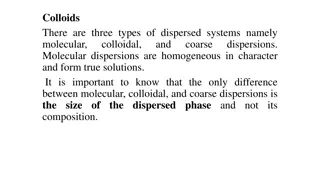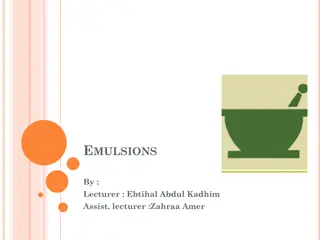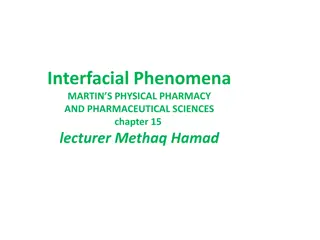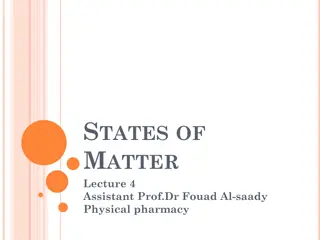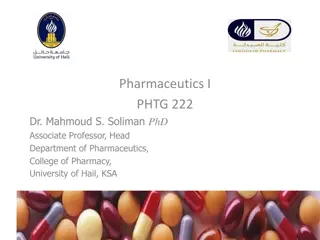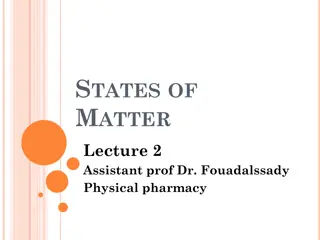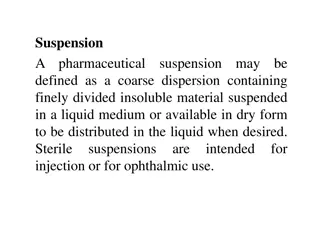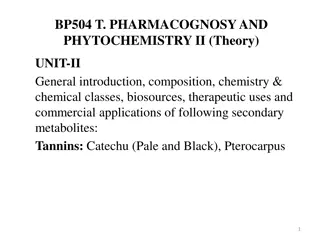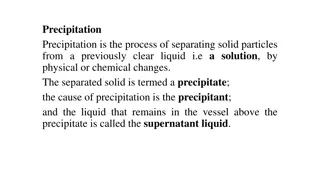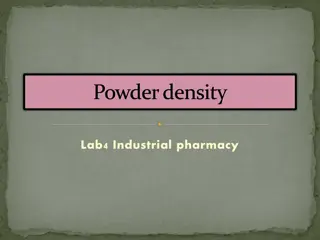Understanding Colloidal Dispersions in Physical Pharmacy
Colloidal dispersions consist of particulate matter distributed throughout a medium. They can be classified based on particle diameter, with molecular, colloidal, and coarse dispersions being common types. The enormous surface area of colloidal particles leads to unique properties, such as catalytic activity. Specific surface area plays a crucial role in defining these properties.
Download Presentation

Please find below an Image/Link to download the presentation.
The content on the website is provided AS IS for your information and personal use only. It may not be sold, licensed, or shared on other websites without obtaining consent from the author. Download presentation by click this link. If you encounter any issues during the download, it is possible that the publisher has removed the file from their server.
E N D
Presentation Transcript
Colloidal Dispersions MARTIN S PHYSICAL PHARMACY AND PHARMACEUTICAL SCIENCES chapter 16 lecturer Methaq Hamad
Dispersed systems consist of particulate matter, known as the distributed throughout dispersion medium. The dispersed material may range in size from particles of atomic and molecular dimensions to particles whose size is measured in millimeters. convenient means of classifying dispersed systems is on the basis of the mean particle diameter of the dispersed material. dispersed continuous phase, a or Accordingly, a
Types of dispersed systems 1. molecular dispersions. 2. Colloidal dispersions. 3. coarse dispersions. 1. Molecular dispersions (less than 1 nm) Particles invisible in electron microscope Pass through semipermeable membranes and filter paper, Particles do not settle down on standing Undergo rapid diffusion E.g. ordinary ions, glucose
2.Colloidal dispersions (1 nm - o.5 um) Particles not resolved by ordinary microscope, can be detected by electron microscope. Pass through filter paper but not pass through semipermeable membrane. Particles made to settle by centrifugation Diffuse very slowly E.g. colloidal silver sols, natural and synthetic polymers, cheese, butter, jelly, paint, milk, shaving cream. 3- Coarse dispersions (> 0.5 um) Particles are visible under ordinary microscope. Do not pass through filter paper or semipermeable membrane. Particles settle down under gravity do not diffuse E.g. emulsions, suspensions, red blood cells.
Size and Shape of Colloidal Particles Particles in the colloidal size range possess a surface area that is enormous compared with the surface area of an equal volume of larger particles. Thus, a cube having a 1-cm edge and a volume of 1 cm3 has a total surface area of 6 cm2. If the same cube is subdivided into smaller cubes each having an edge of 100 m, the total volume remains the same, but the total surface area increases to 600,000 cm2. This represents a 105-fold increase in surface area.
specific surface is defined as the surface area per unit weight or volume of material. In the example just given, the first sample had a specific surface of 6 cm2/cm3, whereas the second sample had a specific surface of 600,000 cm2/cm3. The possession of a large specific surface results in many of the unique properties of colloidal dispersions. For example, platinum is effective as a catalyst only when in the colloidal form as platinum black. This is because catalysts act by adsorbing the reactants onto their surface. Hence, their catalytic activity is related to their specific surface.
The color of colloidal dispersions is related to the size of the particles present. Thus, as the particles in a red gold sol increase in size, the dispersion takes on a blue color. Antimony and arsenic trisulfides change from red to yellow as the particle size is reduced from that of a coarse powder to that within the colloidal size range. Because of their size, colloidal particles can be separated from molecular particles with relative ease. The technique of separation, known as dialysis, uses a semipermeable membrane of collodion or cellophane, the pore size of which will prevent the passage of colloidal particles, yet permit small molecules and ions, such as urea, glucose, and sodium chloride, to pass through. The principle is illustrated in Figure 16-1,
Fig. 16-1.Sketch showing the removal of electrolytes from colloidal material semipermeable membrane. Conditions on the two sides, A and B, of the membrane are shown at the start and at equilibrium. The open circles are the colloidal particles that are too large to pass through the membrane. The solid dots are the electrolyte particles that pass through the pores of the membrane. by diffusion through a
at equilibrium, the colloidal material is retained in compartment A, whereas the subcolloidal material is distributed equally on both sides of the membrane. By continually removing the liquid in compartment B, it is possible to obtain colloidal material in A that is free from subcolloidal contaminants. Dialysis can also be used to obtain subcolloidal material that is free from colloidal contamination in this case, one simply collects the effluent.
Dialysis occurs in vivo. Thus, ions and small molecules pass readily from the blood, through a natural semipermeable membrane, to the tissue fluids; the colloidal components of the blood remain within the capillary system. The principle of dialysis is utilized in the artificial kidney, which removes low molecular-weight impurities from the body by passage through a semipermeable membrane.
The dispersion is important: The more extended the particle the greater its specific surface the greater the attractive force between the particles of the dispersed phase and the dispersion medium. Flow, sedimentation and osmotic pressure of the colloidal system affected by the shape of colloidal particles. Particle shape may pharmacologic action. shape of colloidal particles in also influence the
Fig. 16-2.Some shapes that can be assumed by colloidal particles: (a) spheres and globules, (b) short rods and prolate ellipsoids, (c) oblate ellipsoids and flakes, (d) long rods and threads, (e) loosely coiled threads, and (f) branched threads.
Types of Colloidal Systems A. on the basis of the interaction of the particles, molecules, or ions of the dispersed phase with the molecules of the dispersion medium. 1.Lyophilic Colloids Systems containing colloidal particles that interact to an appreciable extent with the dispersion medium are referred to as lyophilic (solvent-loving) colloids. Owing to their affinity for the dispersion medium, such materials form colloidal dispersions, or sols with relative ease.
lyophilic colloidal sols are usually obtained simply by dissolving the material in the solvent being used. For example, the dissolution of acacia or gelatin in water. The various properties of this class of colloids are due to the attraction between the dispersed phase and the dispersion medium, which leads to solvation, the attachment molecules to the molecules of the dispersed phase. In the case of hydrophilic colloids, in which water is the dispersion medium, this is termed hydration. of solvent
Most lyophilic colloids are organic molecules, for example, gelatin, acacia, insulin, albumin, rubber, and polystyrene. gelatin, acacia, insulin, albumin produce lyophilic colloids in media (hydrophilic polystyrene form nonaqueous, organic materials accordingly are referred to as lipophilic colloids. aqueous sols). lyophilic solvents. dispersion Rubber colloids and in These
2. Lyophobic Colloids The second class of colloids is composed of materials that have little attraction, if any, for the dispersion medium. These are the lyophobic (solvent-hating) colloids. Lyophobic colloids are generally composed of inorganic particles Examples of such materials are gold, silver, sulfur, arsenous sulfide, and silver iodide. In contrast to lyophilic colloids, it is necessary to use special methods to prepare lyophobic colloids. These are (a) dispersion methods, in which coarse particles are reduced in size, dispersed in water.
Dispersion can be achieved by the use of high- intensity ultrasonic generators frequencies in excess of 20,000 cycles per second. A second dispersion production of an electric arc within a liquid. Owing to the intense heat generated by the arc, some of the metal of the electrodes is dispersed as vapor, which condenses to form colloidal particles. Milling and grinding processes can be used, although their efficiency is low. So-called colloid mills, in which the material is sheared between two rapidly rotating plates set close together, reduce only a small amount of the total particles to the colloidal size range. operating at method involves the
(b) condensation methods, in which materials of subcolloidal dimensions are caused to aggregate into particles within the colloidal size range. The required conditions for the formation of lyophobic colloids by condensation or aggregation involve a high degree of initial supersaturation followed by the formation and Supersaturation can be brought about by change in solvent or reduction in temperature. For example, if sulfur is dissolved in alcohol and the concentrated solution is then poured into an excess of water, many small nuclei form in the supersaturated solution. These grow rapidly to form a colloidal sol. growth of nuclei.
Other condensation methods depend on a chemical reaction, such as reduction, oxidation, hydrolysis, and double decomposition. Thus, neutral or slightly alkaline solutions of the noble metal salts, when treated with a reducing agent such as formaldehyde or pyrogallol, form atoms that combine to form charged aggregates.
3. Association Colloids Association or amphiphilic colloids form the third group in this classification. As shown in the Interfacial Phenomena chapter, certain molecules or ions, termed amphiphiles or surface-active agents, are characterized by having two distinct solution affinities within the same molecule or ion. When present in a liquid medium at low concentrations, the separately and are of such a size as to be subcolloidal. As the concentration is increased, aggregation occurs concentration range. These aggregates, which may contain 50 or more monomers, are called micelles. regions of opposing amphiphiles exist over a narrow
Because the diameter of each micelle is of the order of 50 , micelles lie within the size range we have designated concentration of monomer at which micelles form is termed the concentration(CMC). The number of monomers that aggregate to form a micelle is known as the aggregation number of the micelle. as colloidal. The critical micelle
In the case of amphiphiles in water, the hydrocarbon chains face inward into the micelle to form, in effect, their own hydrocarbon environment. Surrounding this hydrocarbon core are the polar portions of the amphiphiles associated with the water molecules of the continuous phase. Aggregation also occurs in nonpolar liquids. The orientation of the molecules is now reversed, however, with the polar heads facing inward while the hydrocarbon chains are associated with the continuous nonpolar phase. These situations are shown in Figure 16-4, which also shows some of the shapes postulated for micelles.
Fig. 16-4.Some probable shapes of micelles: (a) spherical micelle in aqueous media, (b) reversed micelle in nonaqueous media, and (c) laminar micelle, formed at higher amphiphile concentration, in aqueous media.
It seems likely that spherical micelles exist at concentrations relatively close to the CMC. At higher concentrations, laminar micelles have an increasing tendency to equilibrium with spherical micelles. As with lyophilic sols, formation of association colloids is spontaneous, concentration of the amphiphile in solution exceeds the CMC. Amphiphiles may be anionic, cationic, nonionic, or ampholytic (zwitterionic), and this provides a classifying association colloids. form and exist in provided that the convenient means of
Types of Colloidal Systems B. On the base of the original states of their constituent parts:
Table 16-2 Comparison of Properties of Colloidal Sols*
Optical Properties of Colloids 1. The Faraday Tyndall Effect when a strong beam of light is passed through a colloidal sol, the path of light is illuminated (a visible cone formed). This phenomenon scattering of light by the colloidal particles. resulting from the
The same effect is noticed when a beam of sunlight enters a dark room through a slit when the beam of light becomes visible through the room. This happens due to the scattering of light by particles of dust in the air.
2- Electron microscope Ultra-microscope has declined in recent years as it does not able to resolve lyophilic colloids. so electron microscope is capable of yielding pictures of actual particles size, shape and structure of colloidal microscope has high resolving power, as its radiation source is a beam of high energy electrons, while that of optical microscope is visible light. particles. Electron
Electron Microscope Electron Microscope
3- Light Scattering depend information about particle size and shape and for determination of molecular weight of colloids. Used to study proteins, association colloids and lyophobic described in terms of turbidity, T Turbidity: the fractional decrease in scattering as the incident light passes through 1 cm of solution. Turbidity is proportional to the molecular weight of lyophilic colloid. on tyndall effect. used to give sols. Scattering intensity due to
Hc / T = 1/M + 2Bc T: turbidity C: conc of solute in gm / ml of solution M: molecular weight B: interaction constant H: constant for a particular system
Kinetic Properties of Colloids Grouped under this heading are several properties of colloidal systems that relate to the motion of particles with respect to the dispersion medium. The motion may be thermally induced (Brownian movement, diffusion, osmosis), gravitationally induced (sedimentation), or applied externally (viscosity).
1. Brownian Motion Brownian motion describes the random movement of colloidal particles. The erratic motion, which may be observed with particles as large as about 5 m, was explained as resulting from the bombardment of the particles by the molecules of the dispersion medium. The zig-zag movement of colloidal particles continuously and randomly
The motion of the molecules cannot be observed, of course, because the molecules are too small to see. The velocity of the particles increases with decreasing particle size. Increasing the viscosity of the medium, which may be accomplished by the addition of glycerin or a similar agent, decreases and finally stops the Brownian movement.
2. Diffusion Particles diffuse spontaneously from a region of higher concentration to one of lower concentration until the concentration of the system is uniform throughout. Diffusion is a direct result of Brownian movement. According to Fick's first law, the amount, dq, of substance diffusing in time, dt, across a plane of area, S, is directly proportional to the change of concentration, dc, with distance traveled, dx. Fick's law is written as
D diffused per unit time across a unit area when dc/dx (conc. gradient) is unity. The measured diffusion coeffecient can be used to determine the radius of particles or molecular weight. 3. Osmotic Pressure The osmotic pressure, , of a dilute colloidal solution is described by the van't Hoff equation: diffusion coefficient the amount of the material where c is molar concentration of solute. This equation can be used to calculate the molecular weight of a colloid in a dilute solution. Replacing c with cg/M in equation (16-9), in which cg is the grams of solute per liter of solution and M is the molecular weight, we obtain
? R 4- Sedimentation The velocity, v, of sedimentation of spherical particles having a density in a medium of density 0 and a viscosity 0 is given by Stokes's law: osmotic pressure molar gas constant
where g is the acceleration due to gravity. If the particles are subjected only to the force of gravity, then the lower size limit of particles obeying Stokes's equation is about 0.5 m. This is because Brownian movement becomes significant and tends to offset sedimentation due to gravity and promotes mixing instead. Consequently, a stronger force must be applied to bring about the sedimentation of colloidal particles in a quantitative and measurable manner. This is accomplished by use of the ultracentrifuge, which can produce a force one million times that of gravity.
5. Viscosity Viscosity is an expression of the resistance to flow of a system under an applied stress. The more viscous a liquid is, the greater is the applied force required to make it flow at a particular rate. The shapes of particles of the disperse phase affect the viscosity of colloidal dispersions. Spherocolloids form dispersions of relatively low viscosity, whereas systems containing linear particles are more viscous.
Electric Properties Of Colloids Particles dispersed in liquid media may become charged mainly in one of two ways : The first involve selective adsorption of a particular ionic species present in solution. This may be an ion added to the solution or, in the case of pure water, it may be the hydronium or hydroxyl ion. The majority of particles dispersed negative charge due adsorption of the hydroxyl ion. Second : charges on particles arises from ionization of groups (such as COOH) that may be situated at the surface of the particles. in water to acquire preferential a
The Electric Double Layer Consider a solid surface in contact with a polar solution containing ions, for example, an aqueous solution of an electrolyte. Furthermore, let us suppose that some of the cations are adsorbed onto the surface, giving it a positive charge. Remaining in solution are the rest of the cations plus the total number of anions added. These anions are attracted to the positively charged surface by electric forces. In addition to these electric forces, thermal motion tends to produce an equal distribution of all the ions in solution.
An equilibrium situation is set up in which some of the excess anions approach the surface, whereas the remainder are distributed in decreasing amounts as one proceeds away from the charged surface. At a particular distance from the surface, the concentrations of anions and cations are equal, that is, conditions of electric neutrality prevail.
Fig. 15-28. The electric double layer at the surface of separation between two phases,showing distribution of ions. The system as a whole is electrically neutral.
in figure 15-28 aa is the surface of the solid. The adsorbed ions that give the surface its positive charge are referred to as the potential-determining ions. Immediately adjacent to this surface layer is a region of tightly bound solvent molecules, together with some negative ions, also tightly bound to the surface. The limit of this region is given by the line bb in Figure 15-28.


